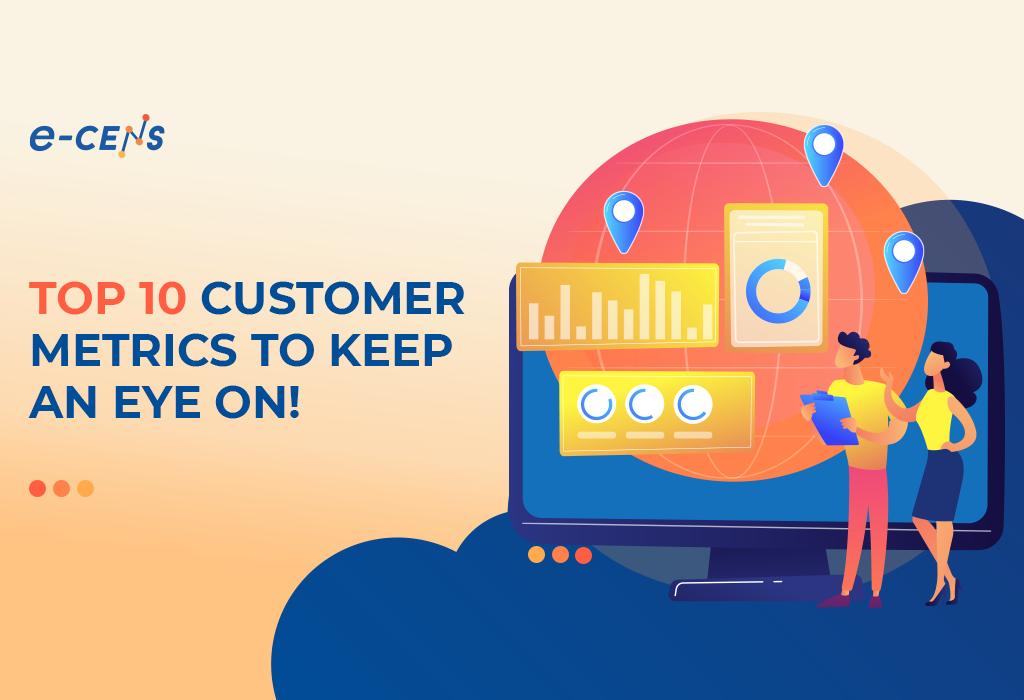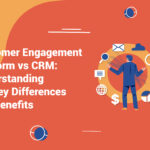The top 10 customer metrics that you have to keep an eye on are:
| Customer Satisfaction (CSAT) | Customer Effort Score (CES) | Net Promoter Score (NPS) |
| Social Media Metrics | Customer Churn | First Response Time |
| Overall Resolution Rate | First Contact Resolution Rate | Customer Ticket Request Volume |
| Average Ticket Handling Time |
- Use CSAT and NPS data to identify areas of strength and weakness in your customer service operations.
- Analyze customer feedback and social media metrics to understand customer pain points and prioritize improvements.
- Monitor resolution rates, response times, and ticket volumes to optimize staffing levels, training, and processes.
- Implement continuous improvement cycles based on metric data, testing new strategies and measuring their impact.
Why Customer Metrics Are Important?
Keeping track of customer metrics is essential for several reasons:
- Understanding customer behavior: By analyzing metrics such as customer satisfaction scores, net promoter scores, and social media engagement, businesses can gain a deeper understanding of how customers perceive their brand, what they like or dislike, and what drives their loyalty.
- Identifying areas for improvement: Metrics can help businesses pinpoint areas where they are underperforming or falling short of customer expectations. This information can then be used to implement targeted strategies and initiatives to enhance the customer experience.
- Measuring the success of initiatives: Customer metrics serve as a barometer for measuring the effectiveness of new products, services, or customer experience initiatives. By tracking relevant metrics before and after implementing changes, businesses can evaluate the impact of their efforts and make necessary adjustments.
Types of customer metrics
Customer metrics can be broadly categorized into two types:
- Experience metrics (X-data): capture the customer’s subjective experience and perceptions. Examples include customer satisfaction scores, net promoter scores, and qualitative feedback.
- Operational metrics (O-data): measure the quantitative aspects of customer interactions, such as response times, resolution rates, and ticket volumes. They provide insights into the efficiency and effectiveness of customer service operations.
Both X-data and O-data are essential for gaining a comprehensive understanding of the customer experience and identifying areas for improvement.
The Top 10 Customer Metrics
Without further ado, let’s dive into the top 10 customer metrics that every business should keep an eye on:
- Customer Satisfaction (CSAT)
- Customer Effort Score (CES)
- Net Promoter Score (NPS)
- Social Media Metrics
- Customer Churn
- First Response Time
- Overall Resolution Rate
- First Contact Resolution Rate
- Customer Ticket Request Volume
- Average Ticket Handling Time
1. Customer Satisfaction (CSAT)
Definition and how to measure: Customer Satisfaction (CSAT) measures customers’ satisfaction with a specific product, service, or interaction. It is typically measured through surveys that ask customers to rate their satisfaction level on a scale, often from 1 to 5 or 1 to 10.

To calculate CSAT, divide the number of satisfied customers (those who answered with 4s and 5s) by the total number of survey responses and then multiply by 100 to get the percentage of satisfied customers.
Tips for using CSAT:
- Measure CSAT after each interaction with a customer service agent to track individual and team performance over time.
- Segment CSAT scores by factors such as product, service, or customer demographics to identify specific areas for improvement.
- Follow up with customers with low CSAT scores to gather additional feedback and address their concerns.
2. Customer Effort Score (CES)
Definition and how to measure: Customer Effort Score (CES) measures the effort a customer exerts to resolve an issue, fulfill a request, or answer a question.
It is calculated by asking customers to rate the level of effort required on a numerical scale, typically ranging from 1 (low effort) to 7 (high effort).
To calculate CES, take the average of all the numerical responses received from customers.
Tips for using CES:
- Aim for a low CES, as it indicates that customers find it easy to interact with your business and resolve their issues.
- Analyze CES scores in conjunction with other metrics, such as CSAT and NPS, to gain a more comprehensive understanding of the customer experience.
- Identify areas of high customer effort and implement strategies to streamline processes and reduce the effort required from customers.
3. Net Promoter Score (NPS)
Definition and how to measure: Net Promoter Score (NPS) measures customer loyalty and willingness to recommend a brand, product, or service to others.
It is calculated by asking customers a single question: “On a scale of 0 to 10, how likely are you to recommend our {product/service/company} to a friend or colleague?”
Customers are then categorized as:
- Promoters (score 9-10): Loyal and enthusiastic customers
- Passives (score 7-8): Satisfied but unenthusiastic customers
- Detractors (score 0-6): Unhappy customers who can damage your brand through negative word-of-mouth
To calculate NPS, subtract the percentage of detractors from the percentage of promoters.
Difference between NPS and CSAT: While CSAT measures satisfaction with a specific interaction or product, NPS gauges overall loyalty and likelihood to recommend the brand.
Tips for using NPS:
- Aim for a high NPS, which indicates a strong base of loyal and enthusiastic customers who can drive growth through positive word-of-mouth.
- Analyze NPS scores by customer segments, such as demographics or product lines, to identify areas for targeted improvements.
- Follow up with detractors to understand and address their concerns proactively, potentially turning them into promoters.
4. Social Media Metrics
Types of metrics to track:
- Brand mentions over time
- Negative comments or complaints
- Technical or account-related questions
- Number of questions that could be answered through support materials
How to measure: Track and analyze social media mentions, comments, and questions related to your brand, products, or services on a monthly basis.
Tips for using social media metrics:
- Monitor social media channels regularly and respond promptly to customer inquiries, complaints, or feedback.
- Use social media analytics tools to track mentions, sentiment, and engagement levels.
- Leverage social media insights to identify common pain points, improve support materials, and enhance the overall customer experience.
5. Customer Churn
Definition: Customer churn, or customer attrition, occurs when a customer stops using a product or service.
How to measure: Identify factors contributing to customer churn, such as declining repeat purchases, reduced purchase amounts, or low customer satisfaction scores. Track these metrics month-over-month to identify potential churn risks.
Tips for reducing churn:
- Analyze customer feedback and behavior to identify the underlying reasons for churn.
- Implement proactive retention strategies like loyalty programs, personalized offers, or targeted communication campaigns.
- Use predictive analytics to identify customers at risk of churning and take preventive actions.
6. First Response Time
Benchmarks:
- Email or online form: 24 hours or less
- Social media: 60 minutes
- Phone: 3 minutes
- Live chat and messaging: Instant
How to calculate: Calculate the time difference between a customer submitting a request and receiving the first response from your support team.
Tips for improving response times:
- Set realistic response time targets based on industry benchmarks and customer expectations.
- Implement processes and tools to prioritize and route customer inquiries efficiently.
- Provide self-service options, such as knowledge bases and chatbots, to address common inquiries quickly.
7. Overall Resolution Rate
What it measures: The overall resolution rate measures the percentage of customer inquiries or issues your support team resolves successfully.
How to calculate: Divide the number of tickets solved by the total number of tickets received.
Tips for improving resolution rates:
- Provide comprehensive training and resources to your support team to ensure they can effectively resolve customer issues.
- Implement a robust knowledge management system to document and share solutions to common issues.
- Gather customer feedback on resolution quality and use it to improve processes and training continuously.
8. First Contact Resolution Rate
What it measures: The first-contact resolution rate measures the percentage of customer inquiries or issues that are resolved during the first interaction without the need for follow-up contacts.
How to calculate: Divide the number of incidents resolved on the first contact by the total number of incidents.
Tips for improving first contact resolution:
- Empower your support team with the necessary tools, knowledge, and authority to resolve issues on the first contact.
- Implement a robust knowledge management system and provide comprehensive training to support agents.
- Analyze cases that require multiple contacts to identify root causes and areas for improvement.
9. Customer Ticket Request Volume
What it measures: Customer ticket request volume tracks the number of support requests or inquiries received over a specific period, such as a week or a month.
How to track over time: Compare the number of support tickets received week over week or month over month to identify trends or spikes in volume.
Tips for reducing ticket volume:
- Analyze ticket data to identify common issues or pain points that can be addressed through improved self-service resources or product enhancements.
- Implement proactive communication strategies to address common issues before customers need to submit a ticket.
- Optimize your knowledge base and self-service resources to empower customers to find answers independently.
10. Average Ticket Handling Time
What it measures: Average ticket handling time measures the average amount of time it takes for support agents to resolve customer inquiries or issues.
How to calculate: Track the time agents spend on each ticket and calculate the average over a specific period, such as a week or a month.
Tips for reducing handling time:
- Provide comprehensive training and resources to support agents in improving their efficiency.
- Implement automation and self-service options to handle routine or straightforward inquiries.
- Analyze cases with extended handling times to identify opportunities for process improvements or additional training.
Making data-informed decisions
While customer metrics provide valuable insights, turning those insights into action is crucial.
Here are some tips for making data-informed decisions:
- Establish clear goals and targets for each metric aligned with your overall customer experience objectives.
- Regularly review and analyze metric data to identify trends, outliers, and areas for improvement.
- Involve cross-functional teams, including customer service, product development, and marketing, in analyzing and interpreting metric data.
- Prioritize initiatives and allocate resources based on the potential impact on customer experience and business outcomes.
Using metrics to improve customer service
Customer metrics should not be viewed as mere numbers; they should guide your efforts to improve the customer experience. Here are some ways to leverage metrics for better customer service:
- Use CSAT and NPS data to identify areas of strength and weakness in your customer service operations.
- Analyze customer feedback and social media metrics to understand customer pain points and prioritize improvements.
- Monitor resolution rates, response times, and ticket volumes to optimize staffing levels, training, and processes.
- Implement continuous improvement cycles based on metric data, testing new strategies and measuring their impact.
Conclusion
Tracking and analyzing customer metrics is essential for businesses to understand customer behaviors, preferences, and experiences comprehensively.
By selecting metrics aligned with business goals and tracking them consistently, companies can identify areas for improvement, optimize customer experiences, and drive long-term success.
Utilizing customer success dashboards and leveraging data-driven insights can help businesses make informed decisions and Stay competitive in the ever-evolving market.
Frequently Asked Questions
Q: Why is customer retention considered a vital customer success metric?
A: Customer retention is crucial as it measures a company’s ability to retain its customers over time. High retention rates indicate customer satisfaction, product quality, and effective customer service. Retaining existing customers is more cost-effective than acquiring new ones, making customer retention a key metric in assessing customer success and improving the overall customer journey.
Q: How can measuring customer churn rate improve your customer experience?
A: Measuring customer churn rate helps businesses understand the rate at which customers stop using their products or services. By analyzing reasons behind churn, companies can identify areas for improvement in customer service, product features, or the overall customer journey. This insight allows businesses to implement strategies to enhance customer satisfaction, reduce churn, and improve the customer experience.
Q: What role does customer lifetime value play in understanding your customer base?
A: Customer lifetime value (CLV) is a critical metric that measures the total revenue a business can expect from a single customer account throughout the business relationship. Understanding CLV allows companies to segment their customer base into high-value customers, enabling more targeted marketing efforts, better resource allocation, and improved strategies to enhance customer service and product offerings for high-value segments.
Q: How can customer feedback be utilized to measure customer service metrics effectively?
A: Customer feedback provides direct insights into customer satisfaction and areas for improvement in products, services, and customer support. Businesses can directly impact key customer service metrics such as response times, resolution times, and overall satisfaction by systematically collecting, analyzing, and acting on customer feedback. Additionally, feedback helps tailor customer support efforts to meet customer needs accurately, enhancing the overall customer experience.
Q: Why is it important to track customer support ticket volume?
A: Tracking customer support ticket volume is essential as it provides insights into the number of issues or inquiries customers face. An increase in ticket volume may indicate a product or service problem, while a decrease could suggest successful resolution of previous issues. Monitoring these trends allows the customer support team to manage resources effectively, prioritize issues, and measure the impact of changes made to improve customer service.
Q: How do metrics and KPIs improve your customer service team’s performance?
A: Metrics and Key Performance Indicators (KPIs) serve as benchmarks for measuring the effectiveness and efficiency of the customer service team. By setting specific, measurable goals based on these metrics, teams can focus their efforts on activities that directly improve customer satisfaction and retention. Regularly reviewing these metrics helps identify areas for improvement, motivates the team by highlighting achievements, and aligns team efforts with the overall goals of improving the customer experience and success.
Q: What is the significance of tracking both qualitative and quantitative customer success metrics?
A: Tracking both qualitative and quantitative customer success metrics provides a holistic view of the customer experience. Quantitative metrics like churn rate and response time offer hard data on customer behavior and support team performance. Qualitative metrics such as customer feedback and satisfaction scores give insights into customers’ perceptions and feelings about their experience. Together, these metrics enable businesses to understand their effectiveness in customer service and identify areas for emotional and operational improvement.








